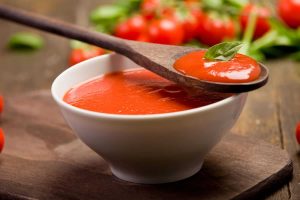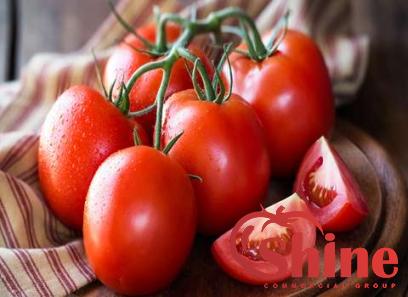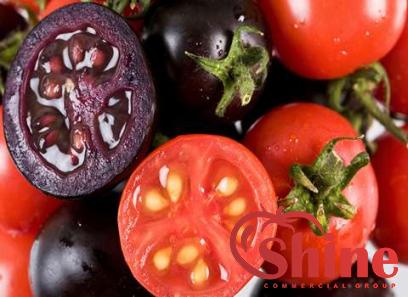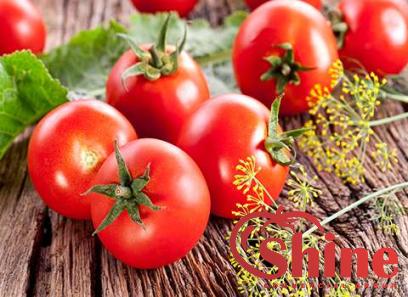There are many benefits of using tomatoes either on skin or on loss of weight. Tomato paste is made by boiling fresh tomatoes until they start to break down. They are then strained to remove the peel and seeds, and boiled for at least a few hours until their moisture evaporates and turns into a thick paste.
Salt and olive oil are usually added, but some commercial products have other flavors and sweeteners added, such as high fructose corn syrup. A 6-ounce can of tomato paste is enough to make a pot of chili or soup for 6 servings of 1 ounce each. The nutritional value provided is one tablespoon, which is about half that amount.
- Lycopene
Tomatoes are the best natural source of lycopene, a powerful antioxidant that belongs to the vitamin A family. It’s frequently in the news for its ability to prevent prostate cancer, but studies have produced mixed results, according to a November 2011 review in the Cochrane Database of Systematic Reviews.
A study published in the October 2012 issue of the journal Neurology reported that men who consumed more lycopene had a lower risk of stroke. There are currently no guidelines for daily lycopene intake, but about 4 to 8 mg per day may be sufficient for health benefits. 1 tablespoon of tomato paste contains 4.6 mg of lycopene.

Tomato paste benefits skin
Vitamin C as one of the prominent components of tomato paste is known as an antioxidant, but it also produces neurotransmitters and collagen, which support your skin and your body’s ligaments. Its antioxidant powers prevent free radical damage throughout your body, including providing antioxidant protection to proteins and fats in your brain. Vitamin C in the skin helps reduce damage from the sun. Men should get 90 mg of vitamin C in their daily diet, while women need 75 mg.
The daily intake for pregnant women is increased to 80 mg. Anyone who smokes needs an extra 35 mg per day. One tablespoon of tomato paste contains 3.5 mg of vitamin C. Dilute tomato sauce with water and broth, as well as dilute canned tomatoes with juices or liquids from the dish you are preparing. In a pinch, it can make a basic tomato sauce, but without seasonings like garlic, onion, paprika, and oregano, the flavor will be bland. Tomato paste is a good base for peppers, stews, and soups.
Try mixing tomato paste, vegetable stock, onions, corn, white beans, green beans, and spices for a delicious vegetarian soup. Combine garlic, shredded carrots, chopped tomatoes, low-salt chicken broth, and tomato sauce for a layer of roast chicken. Eating keto may help protect you from UV rays that can make your face red.
A study published in May 2001 in the Journal of Nutrition showed that taking 40 grams of ketchup and 10 grams of olive oil over 10 weeks reduced skin redness or sunburn by 40 percent. The researchers attributed the lycopene in the paste to this positive result. In the January 2011 issue of the British Journal of Dermatology, a study found that taking 55 grams of ketchup over a 12-week period protected the skin from damage caused by sun exposure.

Tomato paste cancer
Tomato paste is also good for preventing cancer. A serving of keto is only 13 calories and has no fat, which means it’s unlikely to cause weight gain. It also provides 244 IU of vitamin A, an important vitamin for vision health, reproduction, and fetal growth. Although tomato paste doesn’t have as much vitamin C as fresh tomatoes, it still provides 3.5 mg of antioxidants that boost immunity and tissue repair. It is also a source of vitamin K and several B vitamins.
Tomato paste also contains 0.5 mg of iron per tablespoon to help red blood cells function properly. Tomato paste provides 162 mg of potassium per tablespoon to help your body regulate its fluid and mineral stores. The process of making tomato paste makes some of the antioxidants in tomatoes more bioavailable. Antioxidants are compounds that eliminate free radicals in the body that are associated with disease and aging.
A study published in the May 2002 issue of the Journal of Agricultural and Food Chemistry found that the heating process of tomatoes increased the overall antioxidant activity of tomatoes, specifically a substance called lycopene. High intake of tomato products containing lycopene has been linked to a reduced risk of prostate cancer. Manufacturers use ketchup as a base for some juices and ketchup. You can add tomato sauce to marinara or pasta sauces to enhance the flavor and provide a thicker texture. Tomato paste is also an ingredient in many chili and beef soup recipes.
Here are some of the findings, including human participants:
In a randomized trial with 19 participants, daily 33 mg of lycopene from tomato paste improved endothelial function. These improvements may have protective effects on cardiovascular health. A randomized controlled trial showed that lycopene has a protective effect against UV-induced damage. In this trial, 20 women ate a high amount of lycopene by supplementing 55 grams of ketchup per day for 12 weeks. Compared to the control group, the skin of the women in the ketchup group had significantly less signs of UV damage after 12 weeks.
Previous human and animal studies have also demonstrated the UV protective properties of lycopene. A systematic review and meta-analysis of tomato paste and lycopene supplements indicated that the available literature supports beneficial effects on cardiovascular risk factors such as endothelial function, blood lipids, and blood pressure.

Is tomato paste good for weight loss
The inclusion of tomato products, paste or puree is surely helpful and good for weigt loss. Red, juicy and nutrient-dense tomatoes are an integral part of the typical Indian meal. The classic tomato flavor punch is clearly irreplaceable, which is why everything collapses in India every time the price of tomatoes goes up. Tomatoes are essential and necessary for us. Not just at home, if you look around, Spanish, Italian and Mexican cuisines are dominated by red and juicy wonders.
In addition to its unique taste, tomatoes are also very popular, especially among nutritionists and nutritionists, thanks to their rich nutritional value. It is one of the richest sources of vitamin C and beta-carotene, both of which support heart health. It is also rich in lycopene, which has been found to reduce the risk of high cholesterol, protect the eyes and skin, and boost immunity and heart health. Vitamins K, B1, B2, B3, B5, and B6 as well as minerals like potassium, manganese, and iron make tomatoes a popular superfood.
In fact, tomatoes are rich in potassium (267 mg in 100 grams), which makes them ideal for people with high blood pressure. One of the most prominent benefits of adding tomatoes to your diet is their ability to burn fat. Tomatoes are relatively low in calories and carbs, and high in water, making them ideal for those who want to be full without exceeding their daily calorie needs.
Here’s why tomatoes are an ideal addition to a weight loss diet:
1. Low in calories: You will be surprised to learn that 100 grams of tomatoes contain only about 18 calories, making them ideal for those on a calorie restricted weight loss diet.
2. Accelerate the metabolism: tomatoes are rich in antioxidants, and one of their most important components is lycopene. According to experts, lycopene can naturally speed up your metabolism.
3. Curb Cravings: Tomatoes are rich in fiber. Fiber takes longer to digest and stimulates satiety. If you are chronically full, you will naturally crave less and overeat.
4. Good for Digestion: Fiber is very important for good digestion. It increases stool volume, which promotes bowel movements, prevents constipation and facilitates digestion. Indigestion is closely related to being overweight. If you do not have a good digestive system, your ability to absorb and absorb nutrients is impaired, and it is also difficult for you to eliminate waste products and toxins from your body. This affects your metabolism and slows it down.
5. Fat-burning properties: Tomatoes promote the production of an amino acid called carnitine, an organic molecule that plays an important role in the regulation of fatty acids and energy metabolism. This amino acid has been reported to enhance the body’s ability to burn fat

Benefits of tomato paste and milk
Let’s have a look at some of the other benefits of tomato paste. When I make tomato soup, the instructions say heat the canned tomatoes and heat the milk. Add the hot tomato mixture to the hot milk. This seems to set it, so I tried putting a little baking soda in the tomatoes first. This seems to have created some of the white stuff coagulating in the soup. How do I put tomatoes and milk together properly. I hope to make this soup easy because once you add salt, pepper, and parsley, it turns out very tasty.
The recipe is from Real Schmecks Food, a Mennonite cookbook. I would be grateful if you could suggest any solution to my problem. You can put it in power. Top it with other vegetables like olives and basil leaves. Here is a delicious tomato-olive salad recipe from Chef Ajay Chopra that you might like. Tomato juice is also an excellent juice to burn belly fat. You can add other fruits or vegetables and herbs to make it more palatable and filling.
In a blender or food processor, combine 2 cups of water, tomato paste, lemon juice, and salt until you get a smooth consistency. If you find that the juice is too thick, stir in 2-3 cups of water into the mixture. You can put it in soups and soothing broths. For those looking for the perfect recipe. Search no further. Here’s a heart-shaped carrot and tomato soup for those days that want to be light. Hide them secretly next to you. Grilled fish or chicken with grilled tomatoes, beans and olive oil.
You can chop it up and add it to your sprouts. For a healthy breakfast, you can use tomatoes for a quick vegetarian omelet or a tomato and cucumber sandwich. So, what are you waiting for? It’s time to enjoy a delicious and healthy meal. However, be sure not to overuse it. Check sensitivity and serving sizes before starting the download.

Eating tomato paste raw
Eating raw tomato paste is possible. Tomato paste is processed and cooked to remove moisture, resulting in a dense, concentrated product. It’s constantly cooked during the manufacturing process, and there’s nothing unsafe about eating ketchup raw or straight from the can or tube. However, it is recommended that ketchup be heated and mixed with other liquids or foods to obtain a more palatable taste and flavour, as it is very strong and may have a sour taste.
Do you often use ketchup in your cooking?
Tomato paste is basically a highly concentrated tomato paste that is made by cooking tomatoes for a long time. Drain the peel and seeds and cook the tomatoes for more aroma. The result is a thick, fiery paste that imparts its rich, sweet, slow-cooked flavor no matter what you add. Most tomato paste that you buy at the store has no seasoning or seasoning, except for a pinch of salt. Some may contain some type of stabilizer to ensure that the paste does not separate.
The product is then packed into small cans and tubes for widespread use by chefs. You’d think ketchup might be fine, but it needs some added fat and calories to get that delicious flavor. Since it is very concentrated and tomatoes are very acidic, when you eat ketchup straight from the can, there is very little acidity. Heat it with some olive oil and you’ll have a delicious and easy sauce that can be used on just about anything.

How is tomato paste made
Let’s have a look at how tomato paste is made. Place tomatoes, oil, and oregano in a large saucepan over medium-high heat. Bring to a boil. Reduce heat to medium-low. Simmer over low heat for 10 minutes or until tomatoes are tender and skin separates from flesh. Let stand for 10 minutes to cool slightly. Remove thyme and discard. Preheat the oven to 160°C/140°C by pushing the fan. Pour the tomato mixture into a large bowl or a fine strainer over a kettle. Discard seeds and skins. Add salt and citric acid to the tomato puree. Stir well. Divide mixture between 2 shallow baking pans.

Bake for 3 hours, stirring every 30 minutes and alternating trays between racks, or until the tomato sauce has thickened and browned and the liquid has evaporated. Let it cool down. Place a spoon in a clean 1-cup glass bowl. Pour excess oil evenly over the batter in the jar. tight cover. Refrigerate for up to 1 month (see note) or freeze for up to 6 months.










Your comment submitted.